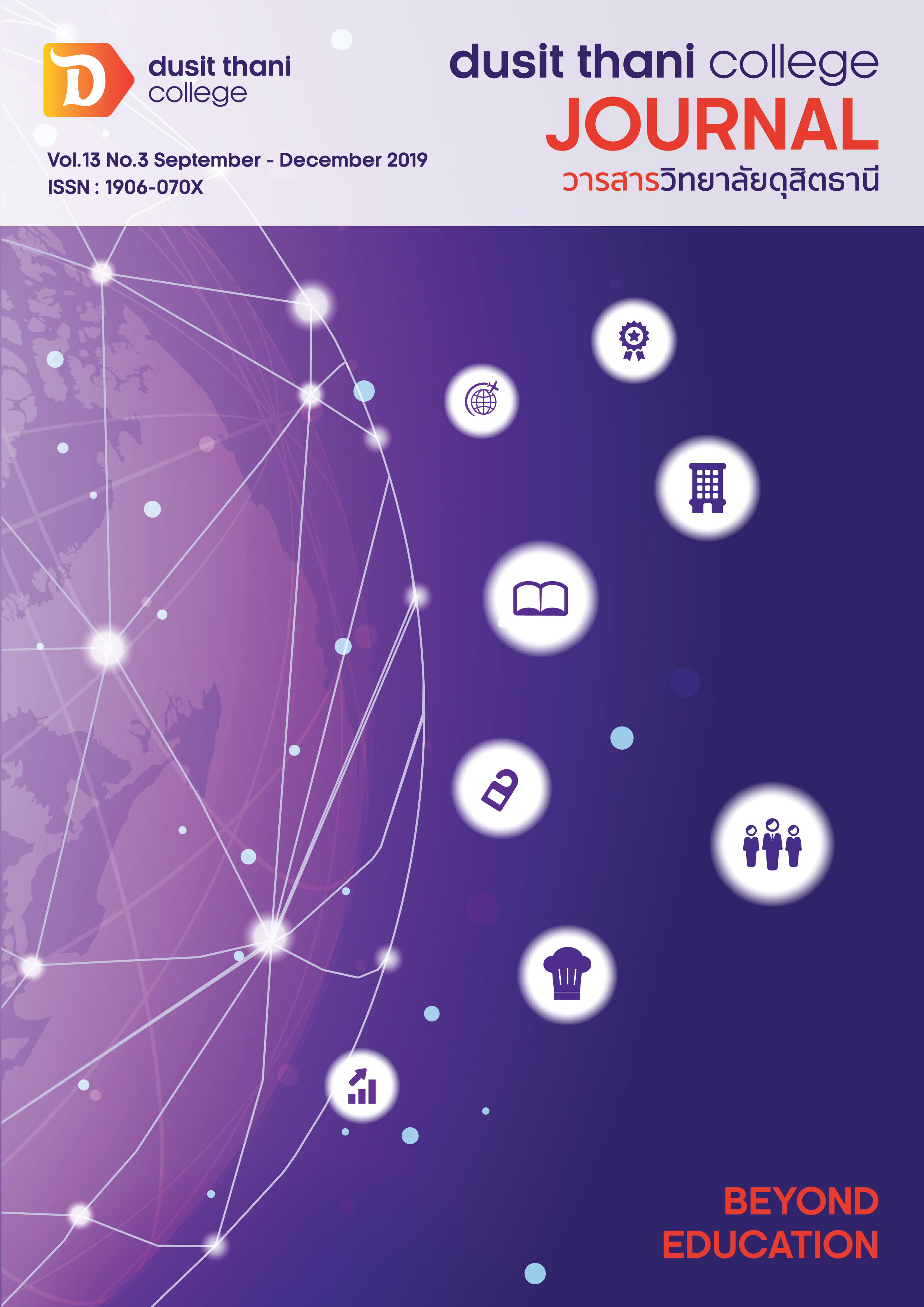Factors of Creating Waterfront Community Tourism Experience: A Case Study of Chantaboon Waterfront Community, Chanthaburi Province
Main Article Content
Abstract
The purposes of this study are to study the personal factors affecting the experience of Thai tourists at Chantaboon Waterfront Community in Chanthaburi Province, and to study the structural equation model of causal factors on tourism motivation factors towards the tourism experience at Chantaboon Waterfront Community in Chanthaburi Province. The appropriate factors for exploratory factor analysis were motivation factors, and travel experiences in visiting Chantaboon Waterfront Community are composed of 42 variables. The samples consisted of Thai tourists aged 18 years and over. The sampling was done of 440 people. The data received were calculated and analyzed using descriptive statistics (frequency, percentage, mean and standard deviation). The Structural equation modeling: SEM was used to test research hypothesis. The study found that the causal relationship of the structural equation model was created consistently with the empirical data. The motivation to travel (MOT) had positive direct effect on the travel experiences (EXP) with statistical significance of 0.01 and the effect size was equal to 0.93. The study on factors related to the motivation to travel and the travel experiences in Chantaboon Waterfront Community, Chanthaburi Province, reported that the most significant variable was the motivation for history and cultures, followed by local attraction and social. The dependent variable which was travel experiences revealed the most significant variable as experience on participatory activity, followed by local cultures, architectural traces and finally tourist attractions.
Article Details
Article Screening Policy
- All research and academic articles to be published must be considered and screened by three peer reviews in the relevant field / article.
- All articles, texts, illustrations and tables published in the journal are the personal opinions of the authors. Editors don't always have to agree. And no responsibility whatsoever is the sole responsibility of the author.
- The articles to be published must never be published. Where did you first publish? And not in the consideration of other journals If the audit found that there has been a duplicate publication It is the sole responsibility of the author.
- Any article that the reader sees as being plagiarized or impersonated without reference. Or mislead the work of the author Please let the journal editor know it will be your greatest blessing.
References
2. Arnamwat, Chayapa. (2011). Chantaboon Waterfront Community: Community management through cultural resources. (Master thesis), Mahidol University. (In Thai)
3. Cetin, G., & Bilgihan, A. (2015). Components of Cultural Tourists’ Experiences in Destinations. Current Issues in Tourism. DOI: 10.1080/13683500.2014.994595
4. Cochran, W. G. (1977). Sampling techniques. 3th ed. New York: John Wiley & Sons.
5. Cutler, S. Q., & Carmichael, B. A. (2010). The dimensions of the tourist experience.
The tourism and leisure experience: Consumer and managerial perspectives, 3-26.
6. Diamantopoulos, A. & Siguaw, J. A., (2000). Introduction to LISREL: A guide for the uninitiated. London: SAGE Publication, Inc.
7. Field, A. (2005). Discovering Statistics Using SPSS. 2nd ed. London: SAGE Publications Ltd.
8. Gao, L., Scott, N., & Ding, P. (2010). Design of memorable cultural heritage attraction experiences for tourists. Paper presented at the Proceedings of the International Scientific Conference: Culture in the Integrated World.
9. Hair, J. F., Jr., Black, W. C., Babin, B. J., Anderson, R. E., & Tatham, R. L. (2006).
Multivariate Data Analysis. 6th ed. Upper Saddle River, New Jersey: Prentice Hall.
10. Kim, K., Oh, I., & Jogaratnam, G. (2007). College student travel: A revised model of push motives. Journal of Vacation Marketing 13(1): 73-85.
11. McLellan, H. (2000). Experience design. Cyberpsychology & Behavior. 3(1): 59–69.
12. Pine, B.J., & Gilmore, J. H. (1998). Welcome to the experience economy. Harvard Business Review. 76(4): 97-105.
13. Poulsson, S.H.G., & Kale, S.H. (2004). The experience economy and commercial experiences. Boston: Harvard Business.
14. Pullman, M.E., & Gross, M.A. (2004). Ability of experience design elements to elicit emotions and loyalty behaviors. Decision Sciences. 35(3): 551-578.
15. Sekaran, U. (1992). Research Methods for Business – A skill building approach. 2nd ed. United States of America: John Wiley & Sons, Inc.
16. Swarbrooke, J., & Horner, S. (2007). Consumer behavior in Tourism. Oxford: Butterworth-Heinemann.
17. Szende, P., Pang, J.K., & Yu, H. (2013). Experience design in the 13th century: the case of restuarants in Hangzhou. Journal of China Research. 9: 115-132.
18. Tourism Authority of Thailand. (2017). Plan to promote the tourism market for the fiscal year 2560. Bangkok: Tourism Authority of Thailand.
19. Yuan, S., & McDonald, C. (1990). Motivational determinants of international pleasure time. Journal of Travel Research. 24(1): 42-44.


